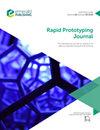一个先进的数字工厂,集成了激光增材和减材制造工艺的数字孪生
IF 3.6
4区 工程技术
Q1 ENGINEERING, MECHANICAL
引用次数: 3
摘要
目的本研究旨在讨论最先进的数字工厂(DF)的发展,结合数字孪生(DT)、传感设备、激光增材制造(LAM)和减法制造(SM)工艺。还强调了DF目前的缺点和前景。DF是一个最先进的制造设施,使用创新技术,包括自动化、人工智能(AI)、物联网、增材制造(AM)、SM、混合制造(HM)、用于实时反馈和控制的传感器以及DT,以简化和改进制造运营。设计/方法论/方法本研究为使用基于激光的AM、SM、传感器和DTs开发测向提供了一个新的视角。对基于激光的AM、SM、传感器和DT的最新发展进行了汇编。本研究是使用系统综述和荟萃分析(PRISMA)指南进行的,讨论了激光AM的DTs文献,特别是激光粉末床聚变和直接能量沉积、原位监测和控制设备、SM和HM。本研究的主要目标是强调DF及其使用现有技术的发展。发现一项全面的文献综述发现,大量缺乏包含网络物理系统、先进数据分析、人工智能、标准化互操作性、人机合作和可扩展适应性的完整技术。建议的DF通过将网络物理系统组件(包括DT、AM、SM和传感器)集成到制造过程中,有效地填补了这一空白。DF使用复杂的数据分析和人工智能算法,促进了实时数据分析、预测性维护、质量控制和最佳资源分配。此外,建议的DF通过强调标准化的通信协议和接口来确保不同设备和系统之间的互操作性。DF的模块化和适应性架构实现了可扩展性和适应性,允许对市场条件做出快速反应。原创性/价值基于测向的需要,本综述提出了一种使用DTs、传感设备、LAM和SM工艺开发测向的综合方法,并提供了该领域的最新进展。本文章由计算机程序翻译,如有差异,请以英文原文为准。
A state-of-the-art digital factory integrating digital twin for laser additive and subtractive manufacturing processes
Purpose
This study aims to discuss the state-of-the-art digital factory (DF) development combining digital twins (DTs), sensing devices, laser additive manufacturing (LAM) and subtractive manufacturing (SM) processes. The current shortcomings and outlook of the DF also have been highlighted. A DF is a state-of-the-art manufacturing facility that uses innovative technologies, including automation, artificial intelligence (AI), the Internet of Things, additive manufacturing (AM), SM, hybrid manufacturing (HM), sensors for real-time feedback and control, and a DT, to streamline and improve manufacturing operations.
Design/methodology/approach
This study presents a novel perspective on DF development using laser-based AM, SM, sensors and DTs. Recent developments in laser-based AM, SM, sensors and DTs have been compiled. This study has been developed using systematic reviews and meta-analyses (PRISMA) guidelines, discussing literature on the DTs for laser-based AM, particularly laser powder bed fusion and direct energy deposition, in-situ monitoring and control equipment, SM and HM. The principal goal of this study is to highlight the aspects of DF and its development using existing techniques.
Findings
A comprehensive literature review finds a substantial lack of complete techniques that incorporate cyber-physical systems, advanced data analytics, AI, standardized interoperability, human–machine cooperation and scalable adaptability. The suggested DF effectively fills this void by integrating cyber-physical system components, including DT, AM, SM and sensors into the manufacturing process. Using sophisticated data analytics and AI algorithms, the DF facilitates real-time data analysis, predictive maintenance, quality control and optimal resource allocation. In addition, the suggested DF ensures interoperability between diverse devices and systems by emphasizing standardized communication protocols and interfaces. The modular and adaptable architecture of the DF enables scalability and adaptation, allowing for rapid reaction to market conditions.
Originality/value
Based on the need of DF, this review presents a comprehensive approach to DF development using DTs, sensing devices, LAM and SM processes and provides current progress in this domain.
求助全文
通过发布文献求助,成功后即可免费获取论文全文。
去求助
来源期刊

Rapid Prototyping Journal
工程技术-材料科学:综合
CiteScore
8.30
自引率
10.30%
发文量
137
审稿时长
4.6 months
期刊介绍:
Rapid Prototyping Journal concentrates on development in a manufacturing environment but covers applications in other areas, such as medicine and construction. All papers published in this field are scattered over a wide range of international publications, none of which actually specializes in this particular discipline, this journal is a vital resource for anyone involved in additive manufacturing. It draws together important refereed papers on all aspects of AM from distinguished sources all over the world, to give a truly international perspective on this dynamic and exciting area.
-Benchmarking – certification and qualification in AM-
Mass customisation in AM-
Design for AM-
Materials aspects-
Reviews of processes/applications-
CAD and other software aspects-
Enhancement of existing processes-
Integration with design process-
Management implications-
New AM processes-
Novel applications of AM parts-
AM for tooling-
Medical applications-
Reverse engineering in relation to AM-
Additive & Subtractive hybrid manufacturing-
Industrialisation
 求助内容:
求助内容: 应助结果提醒方式:
应助结果提醒方式:


